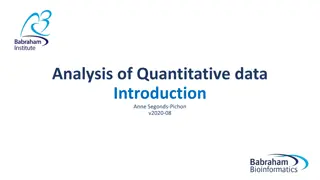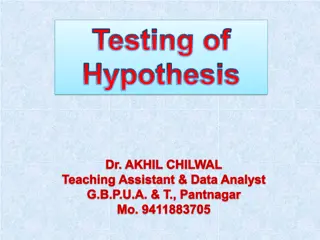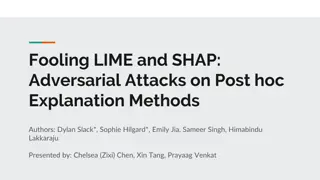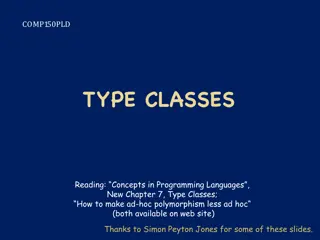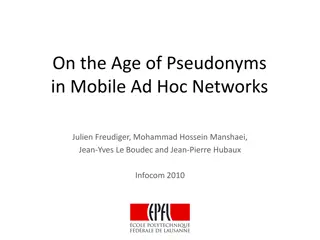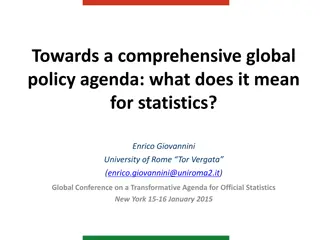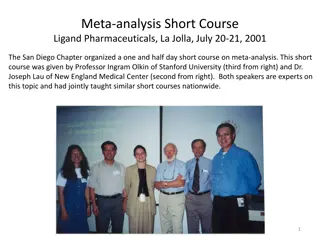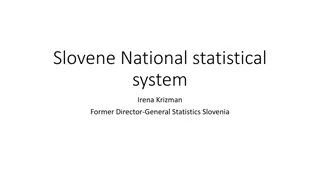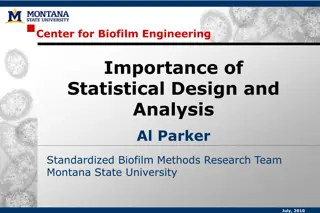Understanding the Importance of Post-hoc Adjustments in Statistical Analysis
Exploring the significance of post-hoc adjustments in statistical testing to avoid reporting spurious effects and maintain integrity in research. The concept of Familywise Error Rate (FWER) and False Discovery Rate (FDR) control methods, as well as the Bonferroni Correction, are discussed to address the issue of inflated Type I errors. The history behind Bonferroni Correction and its derivation adds an interesting perspective to this essential aspect of data analysis.
Download Presentation

Please find below an Image/Link to download the presentation.
The content on the website is provided AS IS for your information and personal use only. It may not be sold, licensed, or shared on other websites without obtaining consent from the author. Download presentation by click this link. If you encounter any issues during the download, it is possible that the publisher has removed the file from their server.
E N D
Presentation Transcript
Advanced Methods and Analysis for the Learning and Social Sciences PSY505 Spring term, 2012 April 18, 2012
Todays Class Post-hoc Adjustments
The Problem If you run 20 statistical tests, you get a statistically significant effect in one of them If you report that effect in isolation, as if it were significant, you add junk to the open literature
The Problem To illustrate this, let s run a simulation a few times, and do a probability estimation spurious-effect-v1.xlsx
The Problem Comes from the paradigm of conducting a single statistical significance test How many papers have just one statistical significance test? How big is the risk if you run two tests, or eight tests? Back to the simulation!
The Solution Adjust for the probability that your results are due to chance, using a post-hoc control
Two paradigms FWER Familywise Error Rate Control for the probability that any of your tests are falsely claimed to be significant (Type I Error) FDR False Discovery Rate Control for the overall rate of false discoveries
Bonferroni Correction Ironically, derived by Miller rather than Bonferroni
Bonferroni Correction Ironically, derived by Miller rather than Bonferroni Also ironically, there appear to be no pictures of Miller on the internet
Bonferroni Correction A classic example of Stigler s Law of Eponomy No scientific discovery is named after its original discoverer
Bonferroni Correction A classic example of Stigler s Law of Eponomy No scientific discovery is named after its original discoverer Stigler s Law of Eponomy proposed by Robert Merton
Bonferroni Correction If you are conducting n different statistical tests on the same data set Adjust your significance criterion to be / n E.g. For 4 statistical tests, use statistical significance criterion of 0.0125 rather than 0.05
Bonferroni Correction Sometimes instead expressed by multiplying p * n, and keeping statistical significance criterion = 0.05 Mathematically equivalent As long as you don t try to treat p like a probability afterwards or meta-analyze it etc., etc. For one thing, can produce p values over 1, which doesn t really make sense
Bonferroni Correction: Example Five tests p=0.04, p=0.12, p=0.18, p=0.33, p=0.55 Five corrections All p compared to = 0.01 None significant anymore p=0.04 seen as being due to chance
Bonferroni Correction: Example Five tests p=0.04, p=0.12, p=0.18, p=0.33, p=0.55 Five corrections All p compared to = 0.01 None significant anymore p=0.04 seen as being due to chance Does this seem right?
Bonferroni Correction: Example Five tests p=0.001, p=0.011, p=0.02, p=0.03, p=0.04 Five corrections All p compared to = 0.01 Only p=0.001 still significant
Bonferroni Correction: Example Five tests p=0.001, p=0.011, p=0.02, p=0.03, p=0.04 Five corrections All p compared to = 0.01 Only p=0.001 still significant Does this seem right?
Bonferroni Correction Advantages Disadvantages
Bonferroni Correction Advantages You can be certain that an effect is real if it makes it through this correction Does not assume tests are independent (in the same data set, they probably aren t!) Disadvantages Massively over-conservative Essentially throws out every effect if you run a lot of tests
Often attacked these days Arguments for rejecting the sequential Bonferroni in ecological studies. MD Moran - Oikos, 2003 - JSTOR Beyond Bonferroni: less conservative analyses for conservation genetics. SR Narum - Conservation Genetics, 2006 Springer What's wrong with Bonferroni adjustments. TV Perneger - Bmj, 1998 - bmj.com p Value fetishism and use of the Bonferroni adjustment. JF Morgan - Evidence Based Mental Health, 2007
Holm Correction Also called Holm-Bonferroni Correction And the Simple Sequentially Rejective Multiple Test Procedure And Holm s Step-Down And the Sequential Bonferroni Procedure
Holm Correction Order your n tests from most significant (lowest p) to least significant (highest p) Test your first test according to significance criterion / n Test your second test according to significance criterion / (n-1) Test your third test according to significance criterion / (n-2) Quit as soon as a test is not significant
Holm Correction: Example Five tests p=0.001, p=0.01, p=0.02, p=0.03, p=0.04
Holm Correction: Example Five tests p=0.001, p=0.011, p=0.02, p=0.03, p=0.04 First correction p = 0.001 compared to = 0.01 Still significant!
Holm Correction: Example Five tests p=0.001, p=0.011, p=0.02, p=0.03, p=0.04 Second correction p = 0.011 compared to = 0.0125 Still significant!
Holm Correction: Example Five tests p=0.001, p=0.011, p=0.02, p=0.03, p=0.04 Third correction p = 0.02 compared to = 0.0166 Not significant
Holm Correction: Example Five tests p=0.001, p=0.011, p=0.02, p=0.03, p=0.04 Third correction p = 0.02 compared to = 0.0166 Not significant p=0.03 and p=0.04 not tested
Less Conservative p=0.011 no longer seen as not statistically significant But p=0.02, p=0.03, p=0.04 still discarded Does this seem right?
Tukeys HSD Method for conducting post-hoc correction on ANOVA Typically used to assess significance of pair-wise comparisons, after conducting omnibus test E.g. We know there is an overall effect in our scaffolding * agent 2x2 comparison Now we can ask is Scaffolding+Agent better than Scaffolding + ~Agent, etc. etc.
Tukeys HSD The t distribution is adjusted such that the number of means tested on is taken into account Effectively, the critical value for t goes up with the square root of the number of means tested on E.g. for 2x2 = 4 means, critical t needed is double E.g. for 3x3 = 9 means, critical t needed is triple
Tukeys HSD Not quite as over-conservative as Bonferroni, but errs in the same fashion
Other FWER Corrections Sidak Correction Less conservative than Bonferroni Assumes independence between tests Often an undesirable assumption Hochberg s Procedure/Simes Procedure Corrects for number of expected true hypotheses rather than total number of tests Led in the direction of FDR
FDR Correction Different paradigm, probably a better match to the original conception of statistical significance
Statistical significance p<0.05 A test is treated as rejecting the null hypothesis if there is a probability of under 5% that the results could have occurred if there were only random events going on This paradigm accepts from the beginning that we will accept junk (e.g. Type I error) 5% of the time
FWER Correction p<0.05 Each test is treated as rejecting the null hypothesis if there is a probability of under 5% divided by N that the results could have occurred if there were only random events going on This paradigm accepts junk far less than 5% of the time
FDR Correction p<0.05 Across tests, we will attempt to accept junk exactly 5% of the time Same degree of conservatism as the original conception of statistical significance
Example Twenty tests, all p=0.05 Bonferroni rejects all of them as non- significant FDR notes that we should have had 1 fake significant, and 20 significant results is a lot more than 1
FDR Procedure Order your n tests from most significant (lowest p) to least significant (highest p) Test your first test according to significance criterion / n Test your second test according to significance criterion / n Test your third test according to significance criterion / n Quit as soon as a test is not significant
FDR Correction: Example Five tests p=0.001, p=0.011, p=0.02, p=0.03, p=0.04 First correction p = 0.001 compared to = 0.01 Still significant!
FDR Correction: Example Five tests p=0.001, p=0.011, p=0.02, p=0.03, p=0.04 Second correction p = 0.011 compared to = 0.02 Still significant!
FDR Correction: Example Five tests p=0.001, p=0.011, p=0.02, p=0.03, p=0.04 Third correction p = 0.02 compared to = 0.03 Still significant!
FDR Correction: Example Five tests p=0.001, p=0.011, p=0.02, p=0.03, p=0.04 Fourth correction p = 0.03 compared to = 0.04 Still significant!
FDR Correction: Example Five tests p=0.001, p=0.011, p=0.02, p=0.03, p=0.04 Fifth correction p = 0.04 compared to = 0.05 Still significant!
FDR Correction: Example Five tests p=0.04, p=0.12, p=0.18, p=0.33, p=0.55 First correction p = 0.04 compared to = 0.01 Not significant; stop
How do these results compare To Bonferroni Correction To Holm Correction To just accepting p<0.05, no matter how many tests are run





